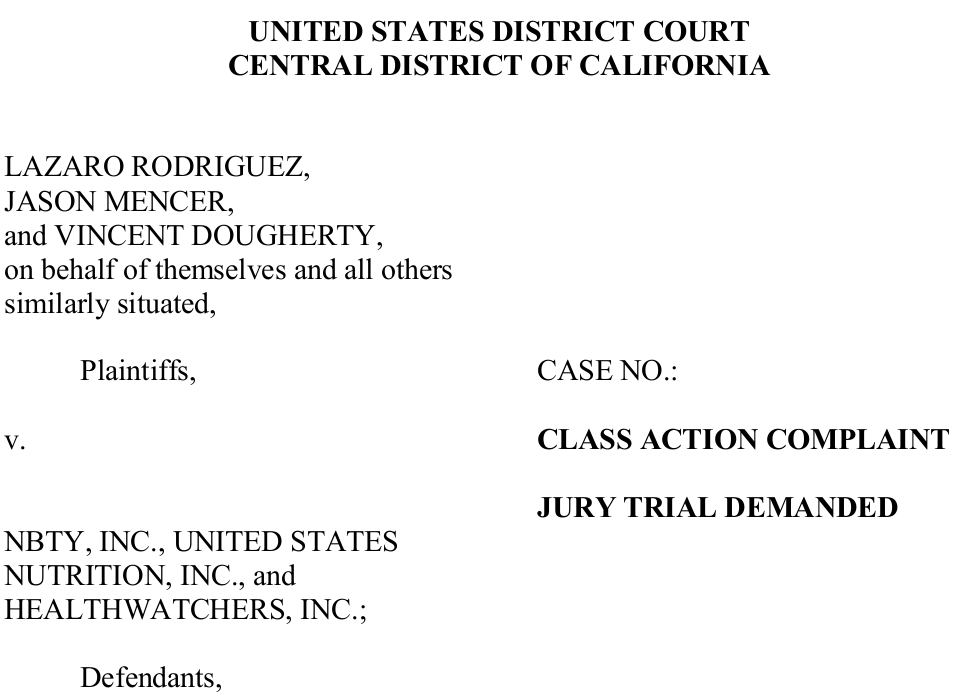Update November 2016: This was the first amino acid spiking case, and it's ever-slowly progressing. Click here to read the November 2016 case updates. This article was originally posted on July 2, 2014.
IT HAS BEGUN.
Last month, we wrote a detailed report about amino acid spiking, which is when a protein manufacturer adds additional low-cost amino acids to protein powders in order to legally "pad the stats" and nudge the amount of protein listed on the label.
The first major shot has been fired: A class action lawsuit against Body Fortress has been filed in California
You can retrieve the publicly available PDF below:
Update, September 24, 2014: Body Fortress has released a new Super Advanced Whey Protein Formula, and we have a lot of questions and concerns to be addressed! See the link for more info.
Lawsuit Summary
- This is a class action complaint filed in California with a jury trial demanded
- It was filed by Jonathan Shub of Seeger Weiss LLP (in PA), Nick Suciu of the Oliver Law Group (in FL), and the law office of Bassma Zebib (in CA)
- It was filed by plaintiffs Lazaro Rodriguez, Jason Mencer and Vincent Dougherty, on 26 behalf of themselves and all others similarly situated
- The offending products are Body Fortress Super Advanced Whey Protein and Body Fortress Super Advanced Whey Isolate
- As expected, they are focusing on the misleading nature of Body Fortress's actions, via the "Sherman Law" in California. The exact wording is "..false, fraudulent, unfair, deceptive and misleading practices.."
- 8.5 grams out of 30 grams of protein are claimed to be spiked. That is a LOT.
- The added free-form aminos listed are the following: Glycine, L-Threonine, L-Glutamine, L-Arginine, L-Alanine, L-Lysine Hydrochloride, L-Leucine, L-Isoleucine, L-Valine, and the non-protein amino acid Taurine.
But overall, if you're interested in nutrition, the lawsuit PDF is very easy to understand. It's more about the science and the products - not too much overwhleming legal jargon.
It's going to get ugly around here...
Before a month ago, the FDA had final say on all regulation of labels. It even superseded the Lanham Act, which lets you sue competitors who engage in unfair deceptive business practices.
This basically meant that in our industry, it was extremely difficult for one food/supplement company to sue another food/supplement company over deceptive labeling claims. That was the FDA's job - end of story...
The Lanham Act is now active for labeled foods and supplements

The supreme court recently ruled that Pom Wonderful may sue Coca-Cola, their competitor, for anti-competitive label claims. Will that decision affect the supplement industry?
This overruling was from the Pom Wonderful vs. Coca-Cola lawsuit about pomegranate products (Coca-Cola's "pomegranate" beverages only contain 0.3% pomegranate juice and Pom wants the ability to sue them).[1]
Now that the decision has been overruled, you can believe that the floodgates will be open for supplement industry lawsuits, especially with so many dubious claims, warring tribes, and monstrous egos involved.
Nutraingredients-USA.com has a good article about this as well, warning scrupulous companies to prepare themselves.[2] Get your flak jackets out!
November 2016 Update
Over two years later, this lawsuit is still going through the legal motion process.
On November 28, United States District Judge Manish S. Shah issued a conclusion (officially a "Memorandum Opinion and Order") on Body Fortress's Motions to Dismiss. You can see the PDF below, after which we'll get into the details:
What was the order?
Judge Shah denied Body Fortress's motions to dismiss on account of Article III standing (explained later), and more importantly, denied their motion to dismiss with respect to plaintiffs’ consumer fraud claims.

Judge Manish S Shah here just threw the book at amino acid spikers - especially if you're going to make claims on the front of the label! However, his arguments may get reversed in an appeal due to this being 'writing law from the bench' that will create even more tort over vegetable proteins.
It's the latter of these two that's most important to consumers -- in plainspoken words, the judge currently seems to agree that the labeling is misleading, or he at least doesn't disagree enough to dismiss it.
Regarding Consumer Fraud Claims
The crux of the latter decision discussed above begins on page 9 in the PDF, under the section B. Regulatory Compliance. It's fantastic to see a judge learn about all of the laws governing food and supplements.
While he understands that "The regulations permit manufacturers to calculate the total amount of protein by multiplying the product’s nitrogen content by a factor of 6.25. See 21 C.F.R. § 101.9(c)(7)", he also found laws that go deeper:
...§ 101.9(c)(7) also refers to another method of calculating protein content. The regulation requires that for any product making a protein claim (everyone agrees that defendants’ product makes such a claim: “60g Premium Protein”), the product must contain a statement of protein content as a percentage of the Daily Reference Value calculated using the “corrected amount of protein”—an amount that is not calculated by simply multiplying the amount of nitrogen by 6.25, but by taking into account the “protein quality value,” or “protein digestibility-corrected amino acid score.” See 21 C.F.R. § 101.9(c)(7)(ii).
-- Judge Manish S. Shah [emphasis ours]
What does 21 C.F.R. § 101.9(c)(7)(ii) say?
This is long, but if you care to read it, it's here:
(ii) The "corrected amount of protein (gram) per serving" for foods represented or purported for adults and children 1 or more years of age is equal to the actual amount of protein (gram) per serving multiplied by the amino acid score corrected for protein digestibility. If the corrected score is above 1.00, then it shall be set at 1.00. The protein digestibility-corrected amino acid score shall be determined by methods given in sections 5.4.1, 7.2.1, and 8.00 in "Report of the Joint FAO/WHO Expert Consultation on Protein Quality Evaluation," except that when official AOAC procedures described in paragraph (c)(7) of this section require a specific factor other than 6.25, that specific factor shall be used...[TRUNCATED]
-- 21 C.F.R. § 101.9(c)(7)(ii)[3]
This leads us down another road of official protein calculation totals that we hadn't yet explored in our original amino acid spiking article.
Report of the Joint FAO/WHO Expert Consultation on Protein Quality Evaluation has been found!
We've finally found this "Report of the Joint FAO/WHO Expert Consultation on Protein Quality Evaluation" -- it's available here on apps.who.int but we've also made a backup here. Thanks to AC Slater (@TheStroBro on Twitter) for finding this document!
Some of the important provisions:
1. 5.4.1 For determination of all amino acids: 1. Three hydrolysates, in duplicate, are required: i. acid hydrolysis of unoxidised protein for determination of all amino acids except tryptophan, methionine and cystine; ii. acid hydrolysis of oxidised protein for detennination of methionine and cystine; this hydrolysate may also be used for the detennination of all other amino acids except tryptophan, tyrosine, phenylalanine and histidine; values for amino acids determined in both acid hydrolysis i) and ii) may be averaged; iii. alkaline hydrolysis of unoxidised protein for tryptophan.
2. 7.2.1- Use the nitrogen testing method for protein (n x 6.25).
3. 8.00- Use nitrogen, but also have to determine individual amino acids by HPLC testing method. Then there is a factor that is used by the type of food being tested, like milk proteins at .95. But, there are no factors for Creatine Monohydrate, Asparagine and Hydroxyproline. So, the factor should be calculated on a weighted average process.
-- Excerpts from the Report of the Joint FAO/WHO Expert Consultation on Protein Quality Evaluation
But as we already know, Creatine Monohydrate is likely the main spiking agent in the Product, yet there is no PDCAAS for Creatine Monohydrate, as it is not a protein or an amino acid. So can you really legally count it as protein as if it were??? Or do we fall back on Kjeldahl when we don't have PDCAAS?
Point being: Amino acid spiking might not be as "technically legal" as many in the industry were led to believe, but it's still undetermined. At one point, many believed certain forms of spiking were "legal but unethical"... and that just might not be the case (at least not if you put a protein claim on the front of the label) if Shah gets his way.
But there's another side to this story...
Where this argument falls apart: Is Shah legislating from the bench?
The problem is that several protein sources are not defined by the sources above. It can be argued that Shah is writing law from the bench here. If this is allowed to stand, then every vegan protein (rice, pea, etc) with a PDCAAS (or DIAAS) score of less than one (like 99% of them) are not labeled right & subject to class action tort cases.
And what about real foods? Any vegan food with "protein" needs to have its facts panel corrected using a PCAAS multiplier & not Kjeldahl? So now can you sue over the protein content in your peas and tofu from the grocery store?
Because of that argument (which is credit to Bruce Kneller), there's a serious chance this gets reversed on appeal.
What is Article III Standing?
The other part of the case that was not dismissed is about jurisdiction and harm. Best from the judge's mouth:
One component of subject-matter jurisdiction is Article III standing—the requirement that plaintiffs present an actual case or controvery...
To establish Article III standing, a plaintiff must show that he has “(1) suffered an injury in fact, (2) that is fairly traceable to the challenged conduct of the defendant, and (3) that is likely to be redressed by a favorable judicial decision.”
-- Judge Manish S. Shah
The class action provisions of Article III standing state that the plaintiff cannot sue on behalf of others who may have been injured. However, since the judge seems favorable to the fact that the plaintiffs in their current jurisdictions may have been injured, he is leaving the case open-ended and is allowing the plaintiff's lawyers to add more classes from other jurisdictions ("the propriety of these plaintiffs pursuing multi-state classes can be revisited at a later stage")
This essentially means that this case may just get bigger, not smaller.
End of the day? This order was not good news for any manufacturer who's been amino acid spiking, and that hopefully means consumers will continue to see protein powder quality rise out of legal necessity.



Comments and Discussion (Powered by the PricePlow Forum)